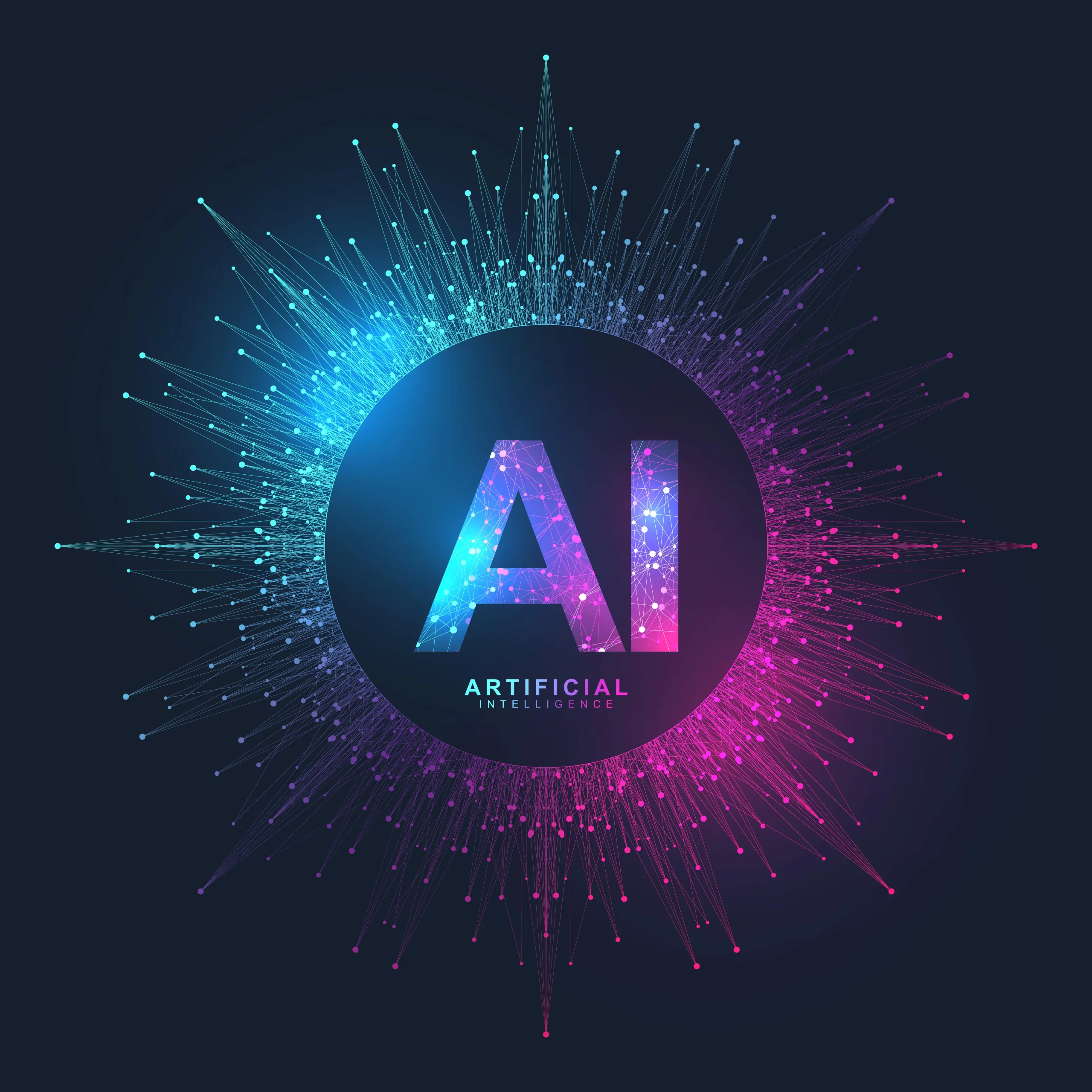Are LLMs and Generative AI Same?
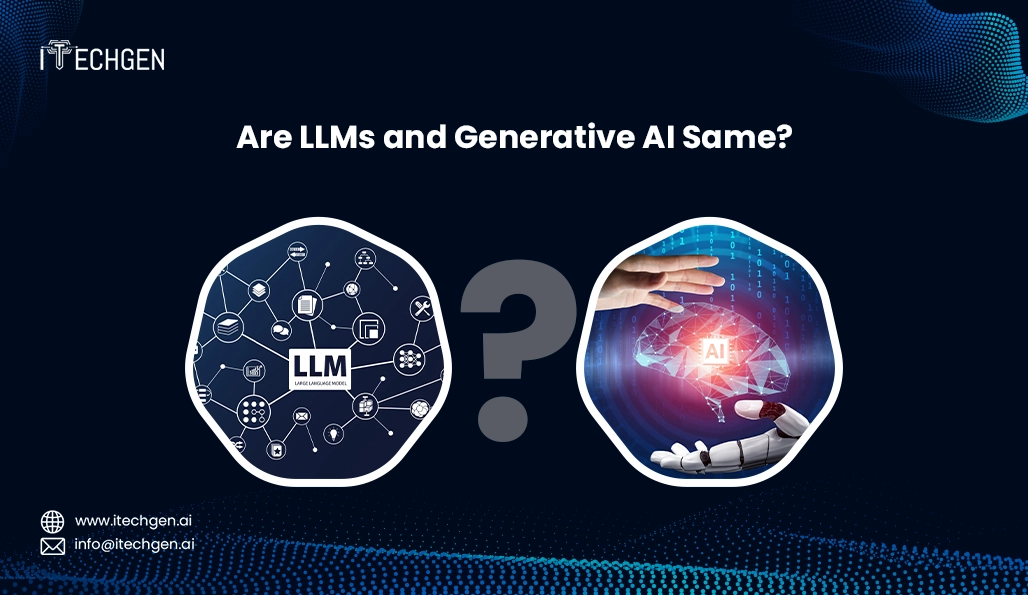
With ChatGPT writing essays, AI tools generating photorealistic imagery, and Automachine code generation tools, the clamoring buzz around Generative AI is seemingly louder than ever. However, as companies scramble toward AI development services, there is one significant uncertainty that keeps resurfacing: Are Large Language Models (LLMs) and Generative AI interchangeable terms? The terminologies are often used synonymously, but they are not actually the same thing.
The global Generative AI market is projected to grow from USD 25.86 billion in 2024 to USD 1005.07 billion by 2034, with a compound annual growth rate (CAGR) of 44.20%.
Similarly, the Large Language Model (LLM) market is expected to expand from USD 5.72 billion in 2024 to USD 123.09 billion by 2034, at a CAGR of 35.92%. These figures underscore the rapid adoption and transformative potential of both technologies across industries.
In this blog, we will help unpack the real difference, demonstrate how they are related to each other, and help you make intelligent decisions for yourself—whether you are developing the next AI app or you’re just interested in how these tools work.
What Are Large Language Models (LLMs)?
Models trained on language are a very specialized category of artificial intelligence (AI) focused on understanding human-like language and generating human-like language. They have been built using very large datasets composed of books, websites, and digital documents. These models are using deep learning, specifically with transformer-based models such as GPT (Generative Pre-trained Transformer) to create language that appears to be human-like and coherent.
LLMs have been around for a few years now, and they fall under the broader umbrella of Generative AI that we mentioned previously. However, they focus specifically on tasks with language, such as answering questions, summarizing language, taking language and translating it, writing code using a programming language, and even holding conversations. They are represented by some popular tools we see today, such as ChatGPT, Claude, and Gemini.
In terms of an AI development services perspective, LLMs are typically built into chatbots, content automation tools, virtual assistants, and other applications leveraging natural language. More businesses are utilizing LLMs so that they can help engage users, automate customer support, and improve productivity while still replicating the same conversationally delicate and human-like attributes.
What Exactly Is Generative AI?
Generative AI is a subsection of artificial intelligence that is enabled to create new content—text, images, audio, code, and even video—by discovering patterns in large sets of data. Generative AI goes beyond traditional patterns of AI recognition/classification to generate outputs that are new to the user and have human-like qualities.
Generative AI tools like GPT, DALL·E and Midjourney each contribute to content creation in their own format. Consequently, Generative AI could become a strong asset for many different sectors that may heavily rely on marketing, customer service, entertainment, and software development.
For companies also considering AI development, Generative AI is a promising technology with relative ease of entry—with its extensive applications of automating content creation, generating personalization of user experience, creating intelligent design apparatuses, and facilitating communication. Generative AI will not just support and replicate human creative thinking and actions—it will allow entities to plan and execute at speeds and scales they have never experienced before.
Key Differences Between LLMs and Generative AI
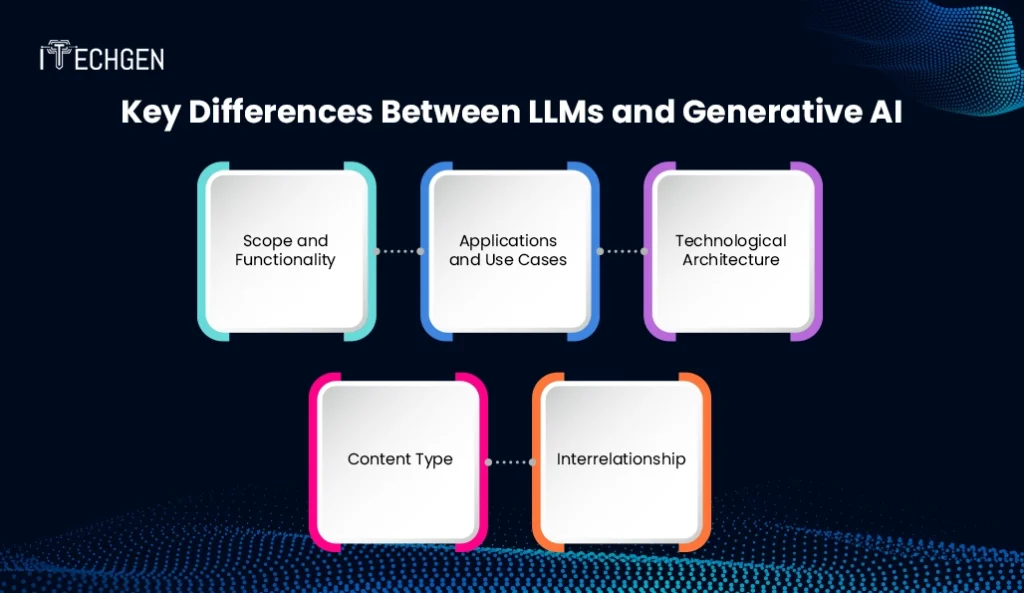
Although, in AI, these two terms are sometimes used interchangeably, Large Language Models (LLMs) and Generative AI are not the same. While there is a close connection between the two, and they usually overlap when actually implemented, they serve specific purposes, are built with a different scope in mind, and offer different capabilities for a given task.
Such distinctions are very important. This becomes relevant especially for businesses that are looking into AI development services. If developing a smart chatbot, content generator, or intelligent design assistant is what you wish to do; understanding the differences between LLMs and Generative AI will help you to select the best approach and tools.
Let’s break it down in detail.
1. Scope and Functionality
LLMs are part of Generative AI that is used specifically for language-related tasks. LLMs aim to read, comprehend, and generate human-like text using deep learning. They are trained on large amounts of text and can perform tasks such as summarizing text, translating text, conducting sentiment analysis, and answering questions with a high degree of accuracy.
Generative AI refers to the capability of models to “generate” not just text but also images, audio, video, and code. It is a large umbrella category that includes LLMs but also includes anything that is able to “generate” content in any format.
2. Applications and Use Cases
LLMs are primarily applied to natural language processing (NLP) tasks—chatbots, content generation, grammar checking, or code writing (e.g., GitHub Copilot). These models perform best in settings where comprehending and producing human language is the main purpose.
Generative AI is more universal. It drives applications such as DALL·E for creating images, Runway for video editing, and Amper Music for sound generation. In AI development services, it helps companies automate creative processes, improve customer experience, and create next-generation applications beyond text.
3. Technological Architecture
LLMs typically use transformer-based architectures—such as GPT (Generative Pre-trained Transformer), BERT, or T5—which are optimized for sequential, language-based data. These models are fine-tuned for specific language tasks and often rely on supervised or reinforcement learning.
Generative AI models vary in architecture depending on their output type. While some use transformers (like LLMs), others may use Generative Adversarial Networks (GANs) for image or video generation, Variational Autoencoders (VAEs) for modeling latent spaces, or diffusion models for higher-quality creative outputs.
4. Content Type
LLMs strictly generate textual content—emails, stories, conversations, code snippets, etc.
Generative AI can generate multiple content types, including text, visual art, synthetic voices, music compositions, and even 3D models.
5. Interrelationship
While all LLMs are a form of Generative AI, not all Generative AI models are LLMs. LLMs are just one specialized component within a much larger Generative AI ecosystem. Think of LLMs as the “text engine” inside the broader creative engine that is Generative AI.
Comparison Table: LLMs vs. Generative AI
| Feature/Aspect | Large Language Models (LLMs) | Generative AI |
| Definition | AI models focused on understanding and generating text | Broad AI category that creates new content of all types |
| Scope | Narrow—language-specific | Broad—text, images, audio, video, etc. |
| Output Type | Text (conversations, articles, code, etc.) | Text, images, video, audio, code, and more |
| Architecture | Primarily transformer-based (e.g., GPT, BERT) | Includes transformers, GANs, VAEs, diffusion models |
| Use Cases | Chatbots, translation, summarization, coding | Image generation, music synthesis, video creation, etc. |
| Relation to Generative AI | Subset—falls under Generative AI | Parent category—includes LLMs as one of many types |
Though typically referred to interchangeably in casual conversation, for the purposes of establishing the differences between LLMs and Generative AI, it is important for practitioners in the field of AI development services to understand their functional differences. Those differences will determine your application. If you are operating in the language space on distinct applications, then LLMs should be leveraged. If you are executing in the visual space, the auditory space, or some other multimedia space, then your broader needs and flexibility will be accommodated by generative AI models.
Understanding the nuances of LLMs and Generative AI will best enable your organization to make sound technological decisions and invest in the right solutions to allow your organization to innovate, grow, and succeed over the long-haul.
Benefits and Limitations of Each
Understanding the strengths and weaknesses of Large Language Models (LLMs) and Generative AI is important for organizations looking to implement intelligent, scalable, and sustainable solutions. Each technology has considerable strengths as well as high costs that must be balanced—especially when spending money on AI development services.
Benefits & Limitations of LLMs
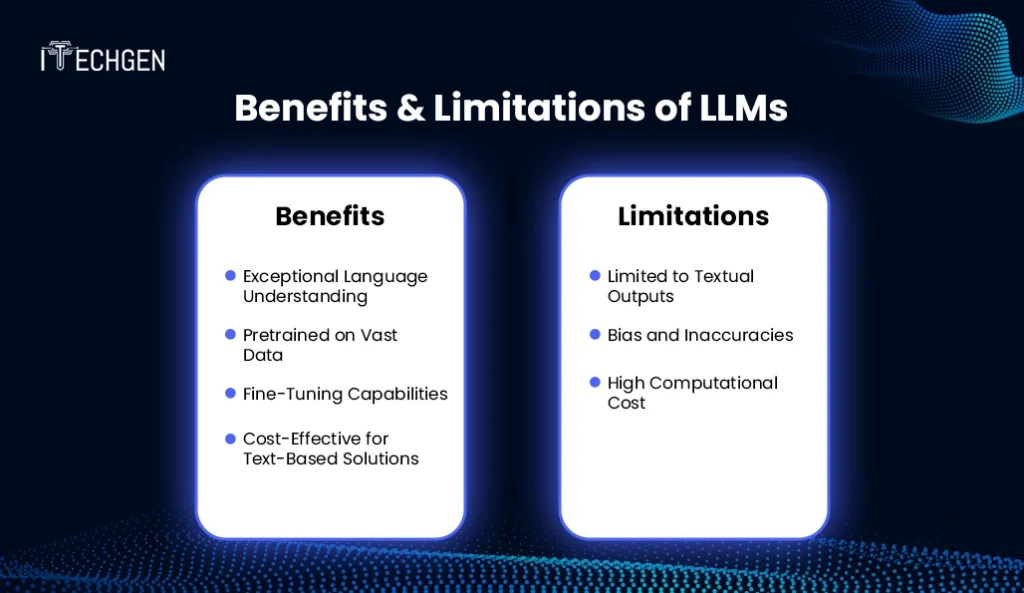
Benefits of LLMs
- Exceptional Language Understanding
LLMs are best suited for processing, comprehension, and production of natural human language, which makes them perfect for tasks such as chatbots, virtual assistants, customer service, and content generation.
- Pretrained on Vast Data
Trained on diverse and massive datasets, LLMs can adapt to multiple industries and tasks without starting from scratch, reducing development time and cost.
- Fine-Tuning Capabilities
LLMs can be fine-tuned for domain-specific use cases—legal, healthcare, e-commerce—providing high accuracy in specialized tasks.
- Cost-Effective for Text-Based Solutions
For businesses with a primary focus on text generation or natural language understanding, LLMs offer a high return on investment with minimal infrastructure requirements.
Limitations of LLMs
- Limited to Textual Outputs
LLMs can’t generate or interpret images, audio, or video, making them unsuitable for projects that demand multimodal content generation.
- Bias and Inaccuracies
Despite their capabilities, LLMs can produce biased, outdated, or factually incorrect information if not properly monitored.
- High Computational Cost
It is a huge computational effort and expertise to train massive LLMs from the ground up that is usually outside the capabilities of smaller organizations.
Benefits & Limitations of Generative AI
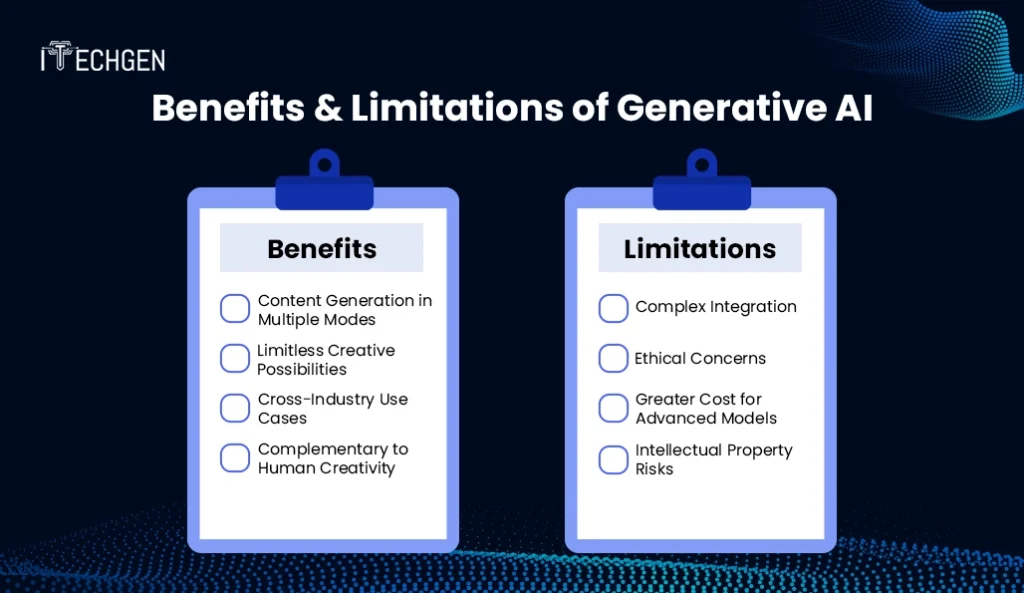
Benefits of Generative AI
- Content Generation in Multiple Modes
Generative AI is able to generate images, music, videos, and 3D objects besides text—which makes it an all-purpose tool for advertising, entertainment, product design, and more.
- Limitless Creative Possibilities
Generative AI enables companies to test and try branding, content, and design in manners that would otherwise take a great deal of human effort and time.
- Cross-Industry Use Cases
From healthcare simulations to automated music production, Generative AI is transforming how industries innovate and engage with customers.
- Complementary to Human Creativity
Rather than substituting for human input, Generative AI is a cooperative partner—improving the speed, scale, and quality of creative output.
Limitations of Generative AI
- Complex Integration
Deploying and managing multi-modal generative models often requires more sophisticated infrastructure and cross-domain expertise.
- Ethical Concerns
Fake content generation (deepfakes, synthetic media) raises significant ethical issues around misinformation and authenticity.
- Greater Cost for Advanced Models
Using advanced models like DALL·E or generative video platforms can come with higher operational and licensing costs.
- Intellectual Property Risks
Since Generative AI tends to learn from open data sources, the legal ownership of generated material can be ambiguous at times.
Takeaway:
Though Large Language Models (LLMs) and Generative AI are related, they play different roles in the changing world of artificial intelligence. LLMs excel in text-based use cases, whereas Generative AI unlocks the potential for multi-format content creation—ranging from writing to visual design and more. Understanding when to apply each can enable businesses to unlock increased efficiency, creativity, and innovation.
If you’re going to incorporate these technologies into your business, having a good AI development company as your partner can be the key. From strategy to execution, skilled developers can assist in customizing AI models to suit your exact objectives—scalability, ethical standards, and long-term value.
Knowing the difference is only the start. The actual change begins when you get the proper AI tools working for your business.

Pankaj Arora (Founder & CEO)
Pankaj Arora is the Founder & CEO of iTechGen, a visionary leader with a deep passion for AI and technology. With extensive industry experience, he shares expert insights through his blogs, helping businesses harness the power of AI to drive innovation and success. Committed to delivering customer-first solutions, Pankaj emphasizes quality and real-world impact in all his endeavors. When not leading iTechGen, he explores emerging technologies and inspires others with his thought leadership. Follow his blogs for actionable strategies to accelerate your digital transformation and business growth.
View More About Pankaj Arora
